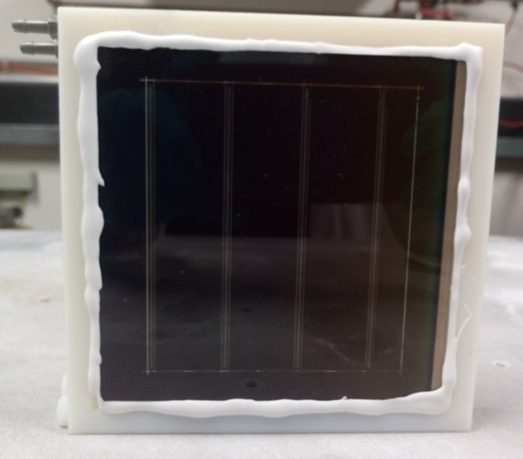- Researchers at Germany’s Jülich Institute for Energy and Climate Research (IEK-5) have created a photovoltaic–electrochemical (PV-EC) water-splitting device powered by solar energy.
The integrated PV-EC device with an active area of 0.5 cm2 was developed with solar panels based on triple‐junction thin‐film silicon solar cells with an efficiency rating of 10.8% and an electro-deposited bifunctional nickel iron molybdenum water‐splitting catalyst.
“The introduction of a triple‐junction Si solar cell offers the possibility of manufacturing a self‐contained base unit without the need for additional series interconnection, which is normally required when using single‐ or double‐junction solar cells,” the research team said, adding that a similar approach may also result in more efficient and cheaper devices, as dead areas created by interconnections are avoided. Their efficiency increases by reducing the dead area and increasing their active area.
With an aperture area of 64 cm2 and an active area of 56 cm2, the wireless solar panel is able to provide an open‐circuit voltage of approximately 2.16 V and a voltage at the maximum power point of about 1.72 V, which the scientists claim is enough to enable bias‐free water splitting.
As for the water-splitting catalyst, the scientist developed a bifunctional NiFeMo device prepared by electrodeposition.
“The bifunctional catalysts enable the PV–EC system to get rid of the need for two different catalyst materials for the anode and cathode side, which offers the potential for lower costs of catalyst production and system configuration,” the academics explained. The gas separation membrane, the solar panels, and the catalysts were mounted in a 3D-printed frame.
Compared to conventional water‐splitting systems, the new device is said to have a better light absorbing path, thanks to the superstrate configuration of the solar cells, without inevitable losses due to the interruption of catalysts and bubbles. The catalyst is not transparent and it can absorb some of the light’s wavelengths
The PV-EC device had an initial solar‐to‐hydrogen (STH) efficiency of approximately 7.7% and after 100 hours of operation this efficiency dropped by 17% to 6.40%. “The upscaled prototype device with an aperture area of 64 cm2 was found to be stable for 30 minutes,” researcher Minoh Lee told pv magazine. “Although our upscaled device has shown relatively rapid decrease of the STH efficiency, it is still worth noting that the gas separation is first demonstrated in such a bias-free and wireless device at large scale.”
Lee said the main reason for the failure is the use of improper supporting components, such as unsuitable adhesives between the device body and back cover glass, as well as the unfavorable design of the gas separation, rather than the degradation of PV and the electrocatalyst.
“We expect that the upscaling device can be more stable if suitable design of gas separation is applied and proper adhesive is used in the upscaling device,” Lee added. “If that were to happen, it would be possible to commercialize this technology soon.”
The researchers discuss the device in A Bias‐Free, Stand‐Alone, and Scalable Photovoltaic–Electrochemical Device for Solar Hydrogen Production, recently published in Advanced Sustainable Systems
Author: Emiliano Bellini
This article was originally published in pv magazine and is republished with permission.















